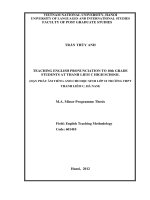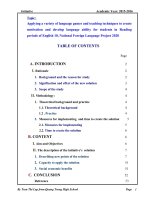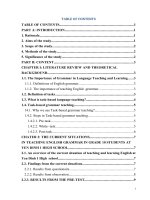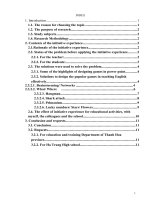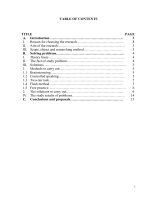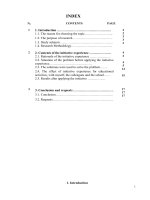teaching english 10
Bạn đang xem bản rút gọn của tài liệu. Xem và tải ngay bản đầy đủ của tài liệu tại đây (1.09 MB, 26 trang )
Teaching & Testing
Teaching & Testing
listening in
listening in
Tieng Anh 10
Tieng Anh 10
Do Tuan Minh
Do Tuan Minh
English Department
English Department
College of Foreign Languages
College of Foreign Languages
Vietnam National University, Hanoi
Vietnam National University, Hanoi
Listening skill in Tieng Anh 10
Listening skill in Tieng Anh 10
•
Lesson 1
Lesson 1
: Reading
: Reading
•
Lesson 2
Lesson 2
: Speaking
: Speaking
•
Lesson 3
Lesson 3
: Listening
: Listening
•
Lesson 4:
Lesson 4:
Writing
Writing
•
Lesson 5:
Lesson 5:
Language focus
Language focus
General objectives
General objectives
Students will be able to:
Students will be able to:
•
listen to a monologue or a dialogue within
listen to a monologue or a dialogue within
120-150 words for general or specific
120-150 words for general or specific
information;
information;
•
do the tasks in the book
do the tasks in the book
What are the tasks?
What are the tasks?
•
Listen and sequencing pictures/events
Listen and sequencing pictures/events
•
Listen and choose True/False statements
Listen and choose True/False statements
•
Listen and fill gaps of missing information
Listen and fill gaps of missing information
•
Listen and answer comprehension questions
Listen and answer comprehension questions
•
Listen and tick the words you hear
Listen and tick the words you hear
•
Listen and complete a table
Listen and complete a table
Principles behind the
Principles behind the
teaching of listening
teaching of listening
•
Principle 1
Principle 1
:
:
The tape recorder is just as
The tape recorder is just as
important as the tape
important as the tape
•
Principle 2
Principle 2
:
:
Preparation is vital
Preparation is vital
Principles behind the
Principles behind the
teaching of listening
teaching of listening
•
Principle 3
Principle 3
:
:
Once will not be enough
Once will not be enough
•
Principle 4
Principle 4
:
:
Students should be encouraged to
Students should be encouraged to
respond to the content of a listening,
respond to the content of a listening,
not
not
just to the language
just to the language
Principles behind the
Principles behind the
teaching of listening
teaching of listening
•
Principle 5
Principle 5
:
:
Different listening stages demand
Different listening stages demand
different listening tasks
different listening tasks
•
Principle 6
Principle 6
:
:
Good teachers exploit listening texts
Good teachers exploit listening texts
to the full.
to the full.
Remember:
Remember:
teach listening
teach listening
NOT
NOT
test listening
test listening
Stages in a listening lesson
Stages in a listening lesson
•
Before-you-listen stage
Before-you-listen stage
•
While-you-listen stage
While-you-listen stage
•
After-you-listen stage
After-you-listen stage
Before you listen
Before you listen
•
Introducing general content of the
Introducing general content of the
listening passage
listening passage
•
Practising designed warming-up
Practising designed warming-up
activities in the textbook
activities in the textbook
•
Making use of pictures (if any) to present
Making use of pictures (if any) to present
new vocabulary
new vocabulary
•
Presenting more words/phrases from
Presenting more words/phrases from
tapescripts
tapescripts
Before you listen
Before you listen
•
Getting students to pronounce
Getting students to pronounce
words/phrases carefully
words/phrases carefully
•
Reviewing already-presented
Reviewing already-presented
grammatical patterns
grammatical patterns
•
Presenting new grammatical patterns
Presenting new grammatical patterns
(if any)
(if any)
•
Asking students to predict content of
Asking students to predict content of
the listening
the listening
While you listen
While you listen
•
Giving clear instructions for the
Giving clear instructions for the
listening task (rephrasing textbook
listening task (rephrasing textbook
instructions if necessary)
instructions if necessary)
•
Playing the tape once (non-stop) for
Playing the tape once (non-stop) for
students to get general content of the
students to get general content of the
listening
listening
•
Providing other activities from textbook
Providing other activities from textbook
for slower classes
for slower classes
While you listen
While you listen
•
Moving from
Moving from
simpler
simpler
tasks
tasks
(listening for
(listening for
getting key words/phrases, listening for
getting key words/phrases, listening for
main ideas, matching, deciding on
main ideas, matching, deciding on
true/false information, numbering
true/false information, numbering
pictures, sequencing events…) to
pictures, sequencing events…) to
more
more
complicated
complicated
ones
ones
(answering MCQs,
(answering MCQs,
gap-filling, table/graph completing,
gap-filling, table/graph completing,
answering information questions …)
answering information questions …)
While you listen
While you listen
•
Playing the tape several times (non-stop
Playing the tape several times (non-stop
or with pauses if students need help)
or with pauses if students need help)
•
Breaking long tapescripts into sections to
Breaking long tapescripts into sections to
facilitate the listening
facilitate the listening
After you listen
After you listen
•
Practising designed post-listening
Practising designed post-listening
activities in textbook.
activities in textbook.
•
Summarising listening passages in
Summarising listening passages in
spoken or written form
spoken or written form
•
Relating to students’ own experience
Relating to students’ own experience
•
Extending the topic to oral or written
Extending the topic to oral or written
presentations
presentations
What if students do NOT understand
What if students do NOT understand
the listening tape?
the listening tape?
•
Introduce interview questions
Introduce interview questions
:
:
Questions can be given first and
Questions can be given first and
students are encouraged to role-play
students are encouraged to role-play
the interview before listening. This will
the interview before listening. This will
increase their predictive power.
increase their predictive power.
What if students do NOT understand
What if students do NOT understand
the listening tape?
the listening tape?
•
Use ‘jigsaw listening’
Use ‘jigsaw listening’
:
:
Different groups are given different
Different groups are given different
bits of the tapescript. When the
bits of the tapescript. When the
groups hear about each other’s
groups hear about each other’s
pieces of tapescript, they can get the
pieces of tapescript, they can get the
whole picture.
whole picture.
What if students do NOT understand
What if students do NOT understand
the listening tape?
the listening tape?
•
One task only
One task only
:
:
Non-demanding tasks can be
Non-demanding tasks can be
assigned such as listening and
assigned such as listening and
deciding on the sex, age, status of the
deciding on the sex, age, status of the
speaker or the setting of the listening.
speaker or the setting of the listening.
What if students do NOT understand
What if students do NOT understand
the listening tape?
the listening tape?
•
Use the tapescript (1)
Use the tapescript (1)
:
:
It can be cut into bits for students to
It can be cut into bits for students to
put in the right order as they listen.
put in the right order as they listen.
What if students do NOT understand
What if students do NOT understand
the listening tape?
the listening tape?
•
Use the tapescript (2)
Use the tapescript (2)
:
:
Students can look at the tapescript to
Students can look at the tapescript to
gain more confidence and ensure
gain more confidence and ensure
what the tape is about.
what the tape is about.
What if students do NOT understand
What if students do NOT understand
the listening tape?
the listening tape?
•
Use the tapescript (3)
Use the tapescript (3)
:
:
Students can look at the tapescript
Students can look at the tapescript
before, during, or after they listen.
before, during, or after they listen.
The tapescript can also have words
The tapescript can also have words
or phrases blanked out.
or phrases blanked out.
Designing a listening test
Designing a listening test
•
Some reminders on the
Some reminders on the
listening passage
listening passage
1.
1.
Length
Length
2.
2.
Lexical density
Lexical density
3.
3.
Use of words
Use of words
4.
4.
Grammatical patterns
Grammatical patterns
Designing a listening test
Designing a listening test
•
Some reminders on the
Some reminders on the
listening tasks
listening tasks
5.
5.
Graded tasks
Graded tasks
6. Cueing tasks
6. Cueing tasks
7. Single purpose tasks
7. Single purpose tasks
8. Over-demanding tasks
8. Over-demanding tasks
Designing a listening test
Designing a listening test
•
Some common types of listening tasks
Some common types of listening tasks
1.
1.
Matching
Matching
2.
2.
Gap-filling
Gap-filling
3.
3.
True/False statements
True/False statements
4.
4.
Short answers
Short answers
5.
5.
Multiple choice questions
Multiple choice questions
6.
6.
Open-ended questions
Open-ended questions
7.
7.
Table/graph completing
Table/graph completing
Designing a listening test
Designing a listening test
•
Some common types of MCQ
Some common types of MCQ
listening tasks
listening tasks
1.
1.
Main idea questions
Main idea questions
2.
2.
Rephrasing questions
Rephrasing questions
3.
3.
Reference questions
Reference questions
4.
4.
Vocabulary questions
Vocabulary questions
5.
5.
Inference questions
Inference questions

